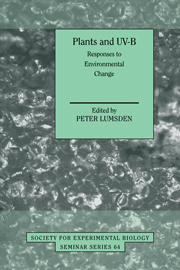Book contents
- Frontmatter
- Contents
- List of contributors
- Preface
- PART I The ozone layer and UV-B radiation
- PART II Effects of UV-B on plants at the cellular level
- DNA damage and repair in plants
- Genetic analysis of DNA repair in plants
- Photosynthesis and photoinhibition
- UV-B effects on the expression of genes encoding proteins involved in photosynthesis
- UV-B perception and signal transduction
- Ultraviolet radiation as a stress factor and the role of protective pigments
- PART III Effects of UV-B at the whole plant and community level
- Index
UV-B effects on the expression of genes encoding proteins involved in photosynthesis
Published online by Cambridge University Press: 04 August 2010
- Frontmatter
- Contents
- List of contributors
- Preface
- PART I The ozone layer and UV-B radiation
- PART II Effects of UV-B on plants at the cellular level
- DNA damage and repair in plants
- Genetic analysis of DNA repair in plants
- Photosynthesis and photoinhibition
- UV-B effects on the expression of genes encoding proteins involved in photosynthesis
- UV-B perception and signal transduction
- Ultraviolet radiation as a stress factor and the role of protective pigments
- PART III Effects of UV-B at the whole plant and community level
- Index
Summary
Introduction
The depletion of ozone in the stratosphere has been of global environmental concern for two decades. Following the Montreal protocol, established to reduce emissions of man-made ozone-destroying chemicals into the atmosphere, the restriction in the use of chlorofluorocarbons (CFCs) in 1990 has noticeably slowed down the rise in chlorine in the stratosphere (Montzka et al, 1996). However, the total ozone destroying power (including levels of bromine and other minor chemicals) in the atmosphere has only levelled and is not yet decreasing (Montzka et al, 1996; Pyle, this volume). One of the consequences of the depletion of stratospheric ozone is the concomitant increase in the level of UV-B radiation from sunlight reaching the surface of the earth. Increases of 10% in UV-B levels in parts of Europe have been reported over the last decade (see Webb, this volume, for more detail), and this increase is predicted to continue into the next century (Blumthaler & Ambach, 1990). UV-B radiation is potentially damaging to all living organisms, but plants are particularly vulnerable to any changes in UV-B levels as they require sunlight for survival and so are unable to avoid exposure to elevated UV-B levels.
The impact of an increase in UV-B on various physiological parameters and morphological features of plants has been extensively studied and reviewed (Bornman & Teramura, 1993; Tevini & Teramura, 1989).
- Type
- Chapter
- Information
- Plants and UV-BResponses to Environmental Change, pp. 113 - 134Publisher: Cambridge University PressPrint publication year: 1997
- 14
- Cited by



